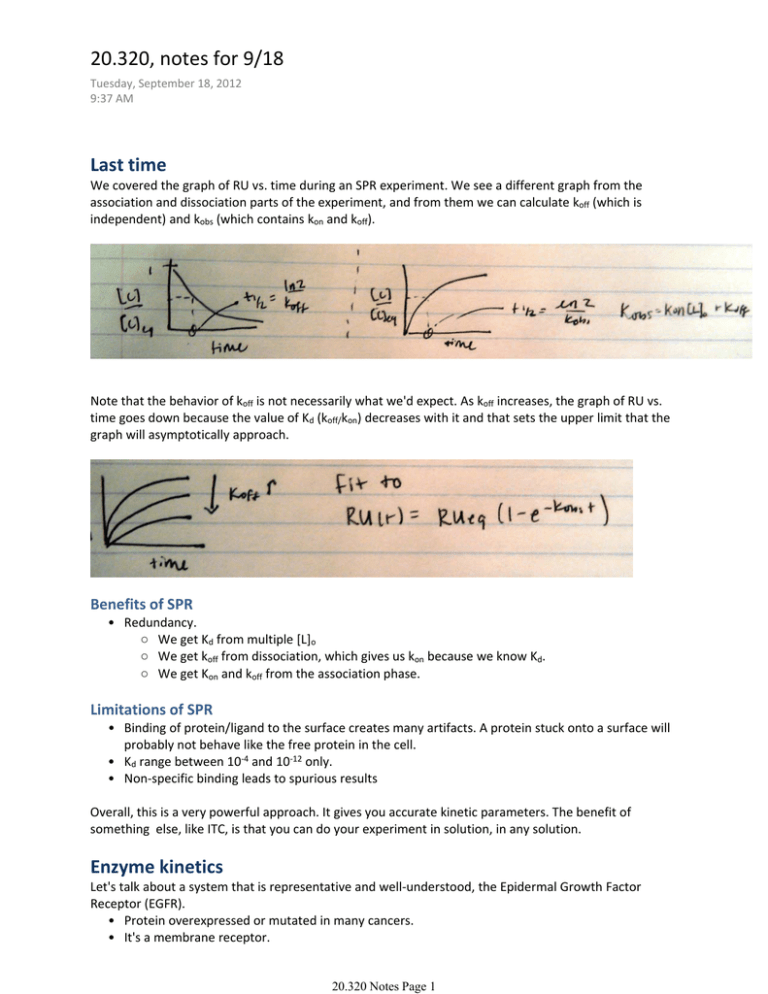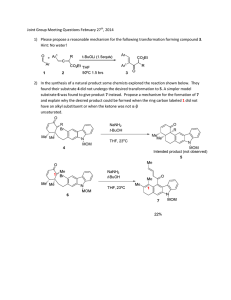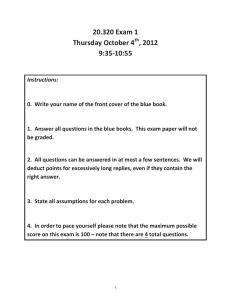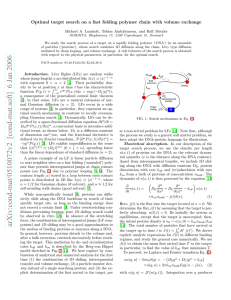advertisement

20.320, notes for 9/18 Tuesday, September 18, 2012 9:37 AM Last time We covered the graph of RU vs. time during an SPR experiment. We see a different graph from the association and dissociation parts of the experiment, and from them we can calculate koff (which is independent) and kobs (which contains kon and koff). Note that the behavior of koff is not necessarily what we'd expect. As koff increases, the graph of RU vs. time goes down because the value of Kd (koff/kon) decreases with it and that sets the upper limit that the graph will asymptotically approach. Benefits of SPR • Redundancy. ○ We get Kd from multiple [L]o ○ We get koff from dissociation, which gives us kon because we know Kd. ○ We get Kon and koff from the association phase. Limitations of SPR • Binding of protein/ligand to the surface creates many artifacts. A protein stuck onto a surface will probably not behave like the free protein in the cell. • Kd range between 10‐4 and 10‐12 only. • Non‐specific binding leads to spurious results Overall, this is a very powerful approach. It gives you accurate kinetic parameters. The benefit of something else, like ITC, is that you can do your experiment in solution, in any solution. Enzyme kinetics Let's talk about a system that is representative and well‐understood, the Epidermal Growth Factor Receptor (EGFR). • Protein overexpressed or mutated in many cancers. • It's a membrane receptor. 20.320 Notes Page 1 • Binds Epidermal Growth Factor (EGF), transforming growth factor α (TGF‐α), and amphiregulin (AREG). EGFR is a Receptor Tyrosine Kinase (RTK). It has a receptor domain outside the cell, and a kinase domain inside the cell that targets many tyrosines on a neighboring receptor of the same kind. When phosphorylated, these receptors recruit other proteins (SH2 and PTB) that have affinity for the phosphorylated tyrosines . This is the start of a signaling pathway that promotes cell proliferation. If overactive, this signal can ultimately lead to cancer. Why do we care? I just told you; cancer. EGFR is one of the most active areas of research in the pharmaceutical industry. People are screening like crazy to find small molecules that interact with these receptors. We are hoping to learn how to predict which sorts of small molecules would best interact with it. What are enzymes? They are catalysts. As such, they facilitate a reaction that neither creates nor consumes them. They reduce the activation energy barrier that prevents the reaction from happening, by stabilizing the intermediate compound that reagents have to transition through on their way to being products. The canonical equation for enzyme kinetics is: Assumptions: • ES ‐> E + P is irreversible. • E does not bind P. 20.320 Notes Page 2 20.320 Notes Page 3 And this is the famous Michaelis‐Menten Equation. Note that the ratio of V to Vmax has a very familiar form. It is essentially a form of fractional saturation. And again, we can take advantage of excess substrate to make the all‐familiar assumption that [S] = [S]o. When is Michaelis‐Menten valid? • Substrate in excess ݀ሾܵܧሿ • ൌ0 ݀ݐ Note that we also have the hidden assumption that our products are forming instantly. In reality, they take a moment at the beginning of the reaction. As the reaction advances through time, there is a linear domain where QSSA applies and the substrate is in great excess. Eventually, though, the substrate gets depleted and your product formation plateaus again. We will calculate the time it takes for a given reaction to undergo these deviations from the ideal case. We'll see when we can assume M‐M as we'd like. If our assumption is that [S] = [S]o, how long to equilibrium? 20.320 Notes Page 4 Again, does this look familiar? We had very similar equations for SPR, since that was modeling protein‐ protein interactions. Remember that the first part of enzyme kinetics is also just protein‐protein interactions. tQSSA is the time it takes to reach 63% of equilibrium. Now, when have we reached substrate depletion? In order for our system to be useful, then, what we want is tQSSA << t[S]. That will be achieved when: 20.320 Notes Page 5 Now, all of the above will be valid only when substrate is in excess. What happens when the substrate is depleted during the association phase? For that, we need to look at the ratio of change in [S] to total [S]. And this is the true condition that is necessary for QSSA—and therefore, for Michaelis‐Menten. Now, how much error is introduced if these conditions are not met? If we did the math, we'd come up with a graph that looks like this. Now, how biologically relevant is this? In the case of EGFR, E = EGFR S = EGFR P = EGFR + PO4 In this case, the substrate and the enzyme are the same molecule. M‐M does not apply. Why do we teach M‐M, then, if it doesn't apply in this enormously important system? Well, because there are lots of cases where it does; around the world of biology, the equation can give us a great approximation. M‐ M is so easy, that it is a great way to get a first approximation in a myriad of systems where we really 20.320 Notes Page 6 don't want to go through all the math. This was a really big deal, during most of the history of biology. We are very lucky, because we have MATLAB and we can bypass these approximations. We can just go and calculate the actual rates of reaction without having to rely on dubious approximations like excess substrate. And one note on 1000% error. How bad is that? This is a good moment to remember a central mantra of modeling. All models are wrong… but some are useful. During your modeling, you should vary your parameters one way and another by 1000%. See if the model cares about variation in that parameter, and thereby determine which things you should care about. Once you pin the important parameters, you can always go and do SPR to figure them out exactly. The point is that there will be a lot of cases where you'll easily get away with 1000% error. Learn to accept that there are different degrees of wrong, and that a little wrong can pay for a whole lot of useful. Finding the balance is our job as bioengineers. 20.320 Notes Page 7 MIT OpenCourseWare http://ocw.mit.edu 20.320 Analysis of Biomolecular and Cellular Systems Fall 2012 For information about citing these materials or our Terms of Use, visit: http://ocw.mit.edu/terms.





